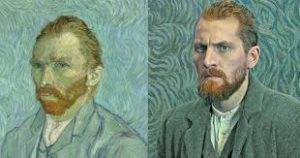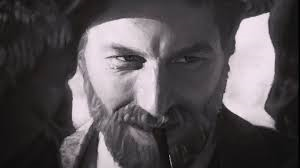SHORT TAKE: Astonishing and beautiful, one of a kind film in which a reluctant messenger plays detective in an attempt to parse out the circumstances of Van Gogh's death, animated in the style of Van Gogh's paintings!
WHO SHOULD WATCH: Anyone interested in classic art, though younger audience members might get bored. Adult themes of mental illness, prostitution, alcoholism and, of course, the death of Vincent Van Gogh – the main topic of the film – are points of discussion, though there is no graphic content of either a sexual or violent nature, and little or no prafane language.
UNFORTUNATELY, SCREENIT.COM HAS NO DETAILED CONTENT STATISTICS ON LOVING VINCENT YET.
LONG TAKE:
The word "unique" is too often blithely thrown around. If you go online you'll find "unique" hair styles and "unique" ice cream stores. "Unique," in fact means "being the only one of its kind; unlike anything else". And there are really only so many ways you can manipulate your hair before redundancy becomes an issue and I'm afraid a truly "unique" ice cream might not be edible. Even so, there are still a few things that genuinely qualify as "unique": Beethoven's Ninth Symphony, each and every individual human soul, Shakespeare's Hamlet, the Mona Lisa and….Loving Vincent.
Loving Vincent is a movie of which there is only one of its kind. Not just different or unusual, though it is that, but actually unique.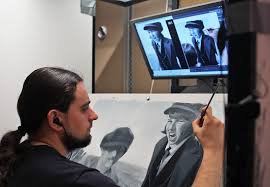 Loving Vincent was animated by over 100 professional artists using 853 backdrops and over 66,000 paintings which, if laid out like a carpet would cover both the entire United Kingdom and the Island of Manhattan.
Loving Vincent was animated by over 100 professional artists using 853 backdrops and over 66,000 paintings which, if laid out like a carpet would cover both the entire United Kingdom and the Island of Manhattan.  80 of the artists were chosen for their professional technique, facility with computers and ability to accurately recreate Van Gogh's style.
80 of the artists were chosen for their professional technique, facility with computers and ability to accurately recreate Van Gogh's style.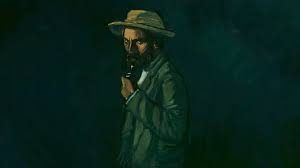
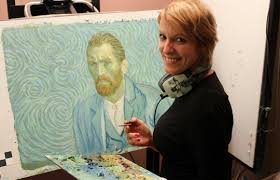 This technique has never before been used. The effect is mesmerizing, like watching one of Van Gogh's paintings come to life before your eyes.
This technique has never before been used. The effect is mesmerizing, like watching one of Van Gogh's paintings come to life before your eyes.
The plot follows Armand Roulin, 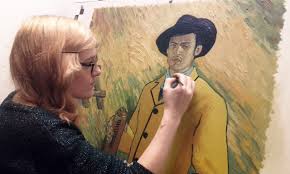
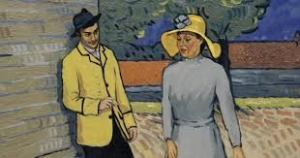 the son of Joseph Roulin, a postmaster who had been a friend of Vincent's. Armand is portrayed and captured as a facile youth who matures during the course of the movie by Douglas Booth who was Romeo in the 2013 Shakespeare film, Shem in Noah and Titus in Jupiter Rising. Booth carries the water of the narrative beautifully as we see the story unfold through his eyes like the petals of the irises featured in one of Van Gogh's paintings.
the son of Joseph Roulin, a postmaster who had been a friend of Vincent's. Armand is portrayed and captured as a facile youth who matures during the course of the movie by Douglas Booth who was Romeo in the 2013 Shakespeare film, Shem in Noah and Titus in Jupiter Rising. Booth carries the water of the narrative beautifully as we see the story unfold through his eyes like the petals of the irises featured in one of Van Gogh's paintings.
 Joseph is captured using Chris O'Dowd, a charming and gentle British comedian who has appeared in roles as varied as Thor: Dark World, the dark and theologically intriguing murder mystery Calvary, the most recent space oriented sci fi installment of the Cloverfield franchise called Cloverfield Paradox, and was in a quirky British comedy about time travel called FAQ About Time Travel.
Joseph is captured using Chris O'Dowd, a charming and gentle British comedian who has appeared in roles as varied as Thor: Dark World, the dark and theologically intriguing murder mystery Calvary, the most recent space oriented sci fi installment of the Cloverfield franchise called Cloverfield Paradox, and was in a quirky British comedy about time travel called FAQ About Time Travel.
Joseph tasks his drunken aimless son with transporting the last letter Vincent wrote to his brother Theo. 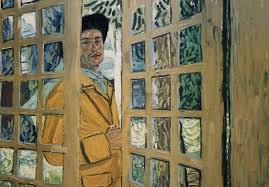 This begins a journey for Armand which will change his perception of the world and himself for the better.
This begins a journey for Armand which will change his perception of the world and himself for the better. 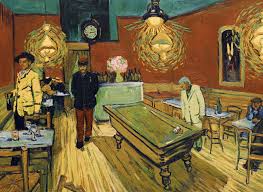 Vincent has been dead for two years by the time Armand starts out and during the course of his travels Armand's adventures transform from a simple delivery to an inquiry into the master painter's life and mysterious circumstances surrounding his death.
Vincent has been dead for two years by the time Armand starts out and during the course of his travels Armand's adventures transform from a simple delivery to an inquiry into the master painter's life and mysterious circumstances surrounding his death. 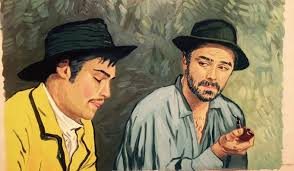 Armand finds out as much about himself as about those who knew Vincent well as he tries to uncover what truths he can concerning the premature demise of this, at that time, unappreciated genius.
Armand finds out as much about himself as about those who knew Vincent well as he tries to uncover what truths he can concerning the premature demise of this, at that time, unappreciated genius.
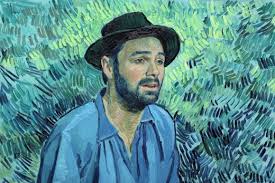 This film would have been an achievement in storytelling had it been done live action and would have rivaled Immortal Beloved whose main protagonist sought the identity of the Immortal Beloved to whom he wished to deliver Beethoven's remaining post mortem letter. Or even the curiosity piquing Citizen Kane as one journalist interviews everyone who knew Kane to try to determine the identity of Rosebud.
This film would have been an achievement in storytelling had it been done live action and would have rivaled Immortal Beloved whose main protagonist sought the identity of the Immortal Beloved to whom he wished to deliver Beethoven's remaining post mortem letter. Or even the curiosity piquing Citizen Kane as one journalist interviews everyone who knew Kane to try to determine the identity of Rosebud. 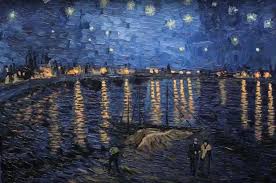 The script is written with sensitivity and three dimensional prose to tweak out the tangles of conflicting evidence amidst the testimonies of those whose only connection was their acquaintance with or love for Vincent. This, as a tale, would have been a great story by itself. But to use the UNIQUE and brilliantly appropriate, though massively ambitious, technique of animating it with Van Gogh style paintings was itself, if you will excuse the intentional pun, a masterstroke by the writers/directors Dorota Kobiela, Hugh Welchman and Jacek Dehnel. This is as different in its own way as the one take-one unbroken shot that Russian Ark was (see a previuos blog).
The script is written with sensitivity and three dimensional prose to tweak out the tangles of conflicting evidence amidst the testimonies of those whose only connection was their acquaintance with or love for Vincent. This, as a tale, would have been a great story by itself. But to use the UNIQUE and brilliantly appropriate, though massively ambitious, technique of animating it with Van Gogh style paintings was itself, if you will excuse the intentional pun, a masterstroke by the writers/directors Dorota Kobiela, Hugh Welchman and Jacek Dehnel. This is as different in its own way as the one take-one unbroken shot that Russian Ark was (see a previuos blog).
Armand seeks out and questions a number of others.
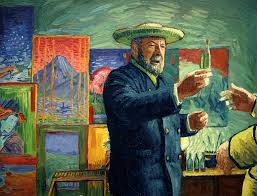 Pere Tanguy (John Sessions) was a friend of Vincent's.
Pere Tanguy (John Sessions) was a friend of Vincent's. 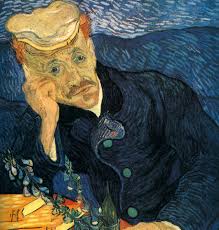
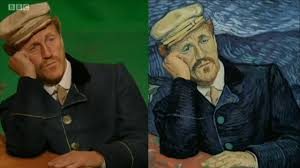 Dr. Gachet (played by Jerome Flynn), who appears in Portrait of Dr. Gachet, had cared for Vincent in his last few months and during the gunshot and subsequent infection that killed Vincent.
Dr. Gachet (played by Jerome Flynn), who appears in Portrait of Dr. Gachet, had cared for Vincent in his last few months and during the gunshot and subsequent infection that killed Vincent. Louise Chevalier, housekeeper to Dr. Gachet (Helen "Narcissa Malfoy" McCrory), who had no use for Vincent and his odd ways.
Louise Chevalier, housekeeper to Dr. Gachet (Helen "Narcissa Malfoy" McCrory), who had no use for Vincent and his odd ways.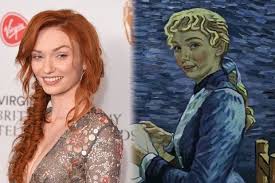
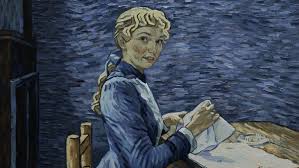 Adeline Ravoux (played by Eleanor Tomlinson)
Adeline Ravoux (played by Eleanor Tomlinson)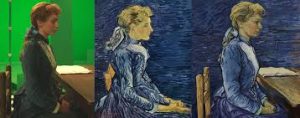 was an innkeeper's daughter who ran the hotel Vincent last stayed in. Adeline was featured in Van Gogh's Portrait of Adeline Ravoux.
was an innkeeper's daughter who ran the hotel Vincent last stayed in. Adeline was featured in Van Gogh's Portrait of Adeline Ravoux. 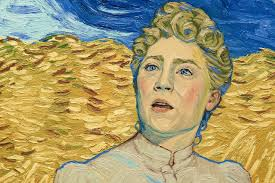
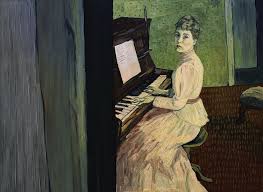
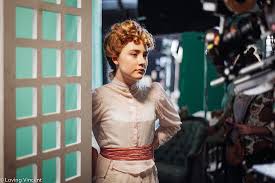 Saoirse Ronan (Ladybird) portrays Marguerite. Marguerite Gachet was the daughter of Dr. Gachet, and is the girl in Van Gogh's painting Margueite Gachet at Piano.
Saoirse Ronan (Ladybird) portrays Marguerite. Marguerite Gachet was the daughter of Dr. Gachet, and is the girl in Van Gogh's painting Margueite Gachet at Piano. 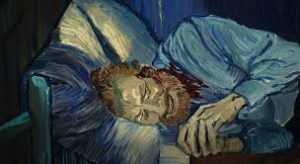
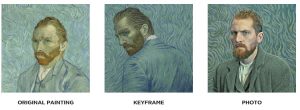
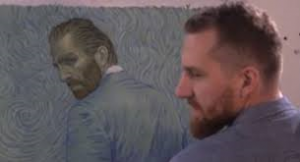 And Robert Gulaczyk, a Polish theater actor, plays Vincent himself and bears a more than passing resemblance to the shy, kind, sensitive and tormented painter. All the actors were chosen, not just for their acting (for the capture) and voice talents but for their resemblance to characters in the actual paintings by Van Gogh.
And Robert Gulaczyk, a Polish theater actor, plays Vincent himself and bears a more than passing resemblance to the shy, kind, sensitive and tormented painter. All the actors were chosen, not just for their acting (for the capture) and voice talents but for their resemblance to characters in the actual paintings by Van Gogh.
 Even the title is creative, evocative and chosen with care. Your "Loving Vincent" is the way Vincent would sign his letters to his brother, Theo. Loving Vincent could refer to the way the painters are expressing their respect and affection for this great artist, as in – this is how we are "loving Vincent", by creating this beautiful movie about him. Or it could be a command to the audience as a demonstration of the way we could appreciate the man and his work – as in, if you watch this movie with the appreciation it deserves you will be "loving Vincent". Or it could simply be a description of the man himself. Loving – as an adjective to describe the great, generous and open heartedness of the man who was the genius master craftsman of the easel – as in – he was a great, a creative, a brilliant but also a loving Vincent.
Even the title is creative, evocative and chosen with care. Your "Loving Vincent" is the way Vincent would sign his letters to his brother, Theo. Loving Vincent could refer to the way the painters are expressing their respect and affection for this great artist, as in – this is how we are "loving Vincent", by creating this beautiful movie about him. Or it could be a command to the audience as a demonstration of the way we could appreciate the man and his work – as in, if you watch this movie with the appreciation it deserves you will be "loving Vincent". Or it could simply be a description of the man himself. Loving – as an adjective to describe the great, generous and open heartedness of the man who was the genius master craftsman of the easel – as in – he was a great, a creative, a brilliant but also a loving Vincent.
It is unfortunate and shortsighted by the Oscar committee that Loving Vincent has been selected to compete in the Oscars as "only" in the animated feature film category. There is precedent to allow animated features to compete in the "Best Picture" category – Beauty and the Beast, Up and Toy Story 3 all were accorded that respect. Loving Vincent MORE than deserves the acknowledgement to be included in the Best Picture category.  This is a serious film about the creative life and mysterious death of one of the world's most beloved master painters.
This is a serious film about the creative life and mysterious death of one of the world's most beloved master painters. 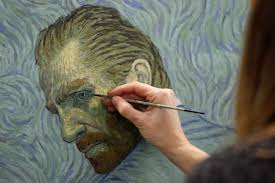 It also only HAPPENS to also be an animated movie.
It also only HAPPENS to also be an animated movie. 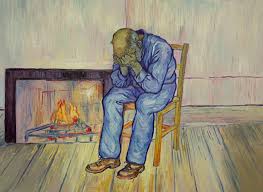 We learn not just about the circumstances of his death but of the complex man whose life was cut far too short
We learn not just about the circumstances of his death but of the complex man whose life was cut far too short 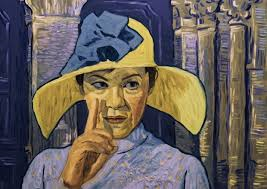 from those who knew him best and in conversations that appear deceptive or misleading at first, as in the style of an Agatha Christie novel, and all come together like some lovingly sculpted three dimensional puzzle.
from those who knew him best and in conversations that appear deceptive or misleading at first, as in the style of an Agatha Christie novel, and all come together like some lovingly sculpted three dimensional puzzle.
 Not only is this movie made WITH beautiful paintings, it IS one big gorgeous animated painting. This is a remarkable work of startlingly pure love – a love letter from these hundreds of artists and actors and seamstresses and animators, caterers and drivers, electricians and sound technicians, not to mention the writers and directors …… to Vincent Van Gogh
Not only is this movie made WITH beautiful paintings, it IS one big gorgeous animated painting. This is a remarkable work of startlingly pure love – a love letter from these hundreds of artists and actors and seamstresses and animators, caterers and drivers, electricians and sound technicians, not to mention the writers and directors …… to Vincent Van Gogh
Watching this movie gave me a new appreciation for Van Gogh's paintings and has inspired me to seek out and learn more about this great man's work.
It also couldn't help but remind me of two other lovingly created items which focused on Vincent Van Gogh. The first is one of the most moving three and a half minutes of cinema I have ever seen. 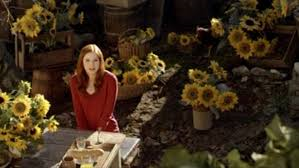
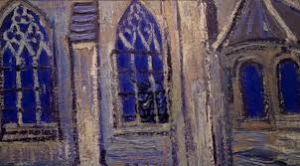

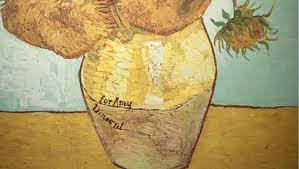
It is near the end of the Dr. Who episode – Vincent. Dr Who and his companion Amy have traveled back in time to meet Vincent Van Gogh. They befriend him and come face to face with the mental and personal struggles of this gentle soul and decide to bring him forward in time to show him the Van Gogh exhibit at the Musee d'Orsay. Tony Curran, as Vincent, does a magnificent job as Van Gogh and the scene is touching, funny and deeply moving. . 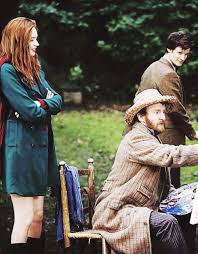
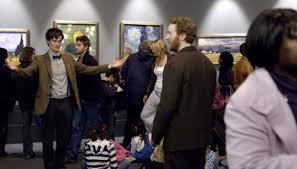
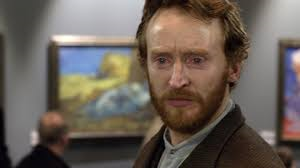 Dr Who excerpt – Vincent at the Musee d'Orsay.
Dr Who excerpt – Vincent at the Musee d'Orsay.
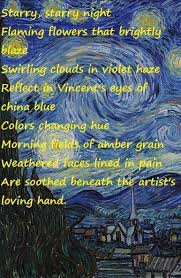 The other bit of Van Gogh fandom which occurred to me was Don McLean's song Vincent. McLean is probably best known for American Pie. The song Vincent came out in the same year, 1971, when I was twelve: "Starry Starry Night, paint your palette blue and gray…how you suffered for your sanity…flaming flowers that brightly blaze, swirling clouds in violet haze…and when no hope was left in sight on that starry starry night you took your life as lovers often do…." The melancholic and beautiful tune sums up the feel of this visually, emotionally, narratively and lyrically moving film. LISTEN TO VINCENT HERE: VINCENT by Don McLean
The other bit of Van Gogh fandom which occurred to me was Don McLean's song Vincent. McLean is probably best known for American Pie. The song Vincent came out in the same year, 1971, when I was twelve: "Starry Starry Night, paint your palette blue and gray…how you suffered for your sanity…flaming flowers that brightly blaze, swirling clouds in violet haze…and when no hope was left in sight on that starry starry night you took your life as lovers often do…." The melancholic and beautiful tune sums up the feel of this visually, emotionally, narratively and lyrically moving film. LISTEN TO VINCENT HERE: VINCENT by Don McLean
WARNING: I really have none except that the topic of suicide may upset the very young.
This film is a gorgeous masterpiece which I like to think that Van Gogh, himself, would have appreciated.
LEARN MORE ABOUT THIS AMAZING MOVIE AND ITS CREATION HERE: LOVING VINCENT WEBSITE
SEE IT ON AMAZON HERE: LOVING VINCENT

